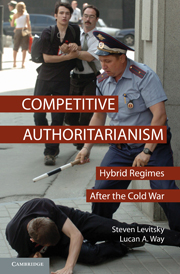Book contents
- Frontmatter
- Contents
- Acknowledgments
- Acronyms and Abbreviations
- Part I Introduction and Theory
- Part II High Linkage and Democratization: Eastern Europe and the Americas
- 3 Linkage, Leverage, and Democratization in Eastern Europe
- 4 Linkage, Leverage, and Democratization in the Americas
- Part III The Dynamics of Competitive Authoritarianism in Low-Linkage Regions: The Former Soviet Union, Africa, and Asia
- 8 Conclusion
- Appendix I Measuring Competitive Authoritarianism and Authoritarian Stability
- Appendix II Measuring Leverage
- Appendix III Measuring Linkage
- Appendix IV Measuring Organizational Power
- References
- Index
4 - Linkage, Leverage, and Democratization in the Americas
Published online by Cambridge University Press: 05 June 2012
- Frontmatter
- Contents
- Acknowledgments
- Acronyms and Abbreviations
- Part I Introduction and Theory
- Part II High Linkage and Democratization: Eastern Europe and the Americas
- 3 Linkage, Leverage, and Democratization in Eastern Europe
- 4 Linkage, Leverage, and Democratization in the Americas
- Part III The Dynamics of Competitive Authoritarianism in Low-Linkage Regions: The Former Soviet Union, Africa, and Asia
- 8 Conclusion
- Appendix I Measuring Competitive Authoritarianism and Authoritarian Stability
- Appendix II Measuring Leverage
- Appendix III Measuring Linkage
- Appendix IV Measuring Organizational Power
- References
- Index
Summary
“Elections are a risky business.…If you get into the game, you should be prepared to lose.”
– Fidel Castro, to Nicaraguan President Daniel OrtegaIn the Americas, five of six competitive authoritarian regimes democratized in the post–Cold War period. As in Eastern Europe, domestic variables cannot easily explain these outcomes. Democratization occurred in the Dominican Republic, Guyana, Nicaragua, and Peru despite underdevelopment, extreme inequality, and presidentialism. Moreover, although Latin America as a region had greater experience with democracy than other regions covered in this book, the cases examined here had little or no democratic experience prior to 1990. Indeed, in all cases except Mexico, the domestic push for democracy was weak.
As in Eastern Europe, regime outcomes in the Americas were powerfully shaped by countries' ties to the West. Latin America – particularly Mexico, Central America, and the Caribbean – is characterized by extensive economic, diplomatic, technocratic, social, and communication linkage to the United States. These ties raised the perceived cost of international isolation, which heightened governments' sensitivity to external pressure. Leverage was also high. Long the region's dominant military and economic power, U.S. influence peaked in the 1990s. Unlike much of Asia and the former Soviet Union, where regional powers limited U.S. influence during the post–Cold War period, the United States exercised “uncontested and complete hegemony” in the Americas. Few issues trumped democracy promotion on the U.S. foreign-policy agenda.
- Type
- Chapter
- Information
- Competitive AuthoritarianismHybrid Regimes after the Cold War, pp. 130 - 180Publisher: Cambridge University PressPrint publication year: 2010



